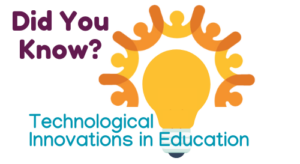Emerging Technologies and Their Implications in Early Childhood


 This article explores a selection of emerging technologies, offering insights into their potential integration within the realm of early childhood.
This article explores a selection of emerging technologies, offering insights into their potential integration within the realm of early childhood.
Over the last decade, technological progression has significantly transformed our methods of living, learning, and connecting with one another. Our youngest members of society, who can be deemed native digital citizens, find themselves enveloped in a world starkly different from that of previous generations.
We must comprehend the subtle complexities of the technology tools and platforms birthed in the 21st century, especially in the context of their application to early childhood education and development.
Presented here is a succinct yet comprehensive examination of 15 emerging technologies, shedding light on their relevance to childhood experiences and the assortment of advantages and challenges they represent.
Artificial Intelligence (AI) – Machines performing tasks requiring human intelligence
Relevance for Children: Educational apps and toys adapting to a child’s learning style
Pros: Personalized learning, enhanced engagement
Cons: Over-reliance, data privacy concerns
Machine Learning – Algorithms allowing computers to learn from data
Relevance for Children: Adaptive learning platforms adjusting content based on a child’s progress
Pros: Tailored education experiences
Cons: Biased algorithms, inappropriate content risks
Blockchain – Decentralized ledger of transactions
Relevance for Children: Secure digital badges and certificates for educational achievements
Pros: Transparent, tamper-proof records
Cons: Complexity, energy consumption
Quantum Computing – Computers using quantum mechanics principles
Relevance for Children: Future educational simulations and problem-solving tools
Pros: Fast computations
Cons: Still in infancy, expensive
5G Technology – Fifth generation of mobile network
Relevance for Children: Faster and more reliable online learning experiences
Pros: Faster data speeds, improved connectivity
Cons: Limited availability, health concerns
Biotechnology – Using biological systems to develop products
Relevance for Children: CRISPR kits for advanced biology lessons
Pros: Hands-on learning, advanced medical treatments
Cons: Ethical concerns, Unintended consequences
Robotics – Design and creation of robots
Relevance for Children: Robotics kits and competitions for students
Pros: STEM engagement, practical learning
Cons: Expensive, can be complex
Nanotechnology – Manipulation of matter on atomic scale
Relevance for Children: Nanotech kits teaching advanced science concepts
Pros: Innovative solutions, miniaturization
Cons: Health concerns, expensive
Edge Computing – Computing at or near data source
Relevance for Children: Localized educational apps running efficiently without internet.
Pros: Fast processing, reduced latency
Cons: Security concerns, limited storage
Neural Networks – Algorithms modeled after human brain
Relevance for Children: Advanced AI toys and games responding to children’s actions
Pros: Pattern recognition, data processing
Cons: Complexity, requires large data sets
Augmented Reality (AR) – Overlaying digital content on the real world
Relevance for Children: AR books and educational games
Pros: Interactive learning, enhanced engagement
Cons: Device dependency, can be distracting
Virtual Reality (VR) – Immersive digital environments
Relevance for Children: Virtual field trips and simulations
Pros: Immersive experiences, safe exploration
Cons: Expensive, health concerns (e.g., eye strain)
Internet of Things (IoT) – Interconnected digital devices
Relevance for Children: Smart toys interacting with each other and the environment
Pros: Interactive environments, learning through play
Cons: Privacy concerns, over-reliance on tech
Smart Cities – Urban areas using IoT sensors for efficiency
Relevance for Children: Safe and interactive urban playgrounds and learning spaces
Pros: Efficient services, enhanced safety
Cons: Privacy issues, expensive to implement
Drones – Unmanned aerial vehicles
Relevance for Children: Drone programming and piloting for students
Pros: Hands-on tech learning, aerial perspectives
Cons: Safety concerns, privacy issues

These pioneering technologies need mindful application. Let’s delve into a few key points:
AI and Machine Learning offer a tailored learning journey. For instance, an educational app might adjust its difficulty level based on a child’s responses, fostering a challenging yet encouraging learning environment. However, it’s paramount to ensure children also engage in non-digital activities, cultivating organic learning experiences.
Robotics and biotechnology provide tactile experiences, allowing children to grasp complex concepts physically. A child assembling a robot or learning about gene editing through a simplified CRISPR kit achieves a deeper understanding. Yet, it’s our responsibility to provide guidance about the ethical ramifications, ensuring a holistic perspective.
While VR can virtually transport a child to the Egyptian pyramids or under the ocean, prolonged use might result in eye strain or other health issues. Balance is key, ensuring these tools supplement rather than replace traditional learning methods.
Incorporating emerging technologies into early childhood should not be a situation of blindly embracing the future but rather should involve making informed, judicious choices.
As educators, parents, and professionals, our aim should be to harness the promise of these tools while being acutely aware of their pitfalls, cultivating an environment where children not only thrive but also grow into discerning digital citizens.
Childhood Education International (CE International) is dedicated to empowering leaders to catalyze innovation and cultivate positive transformations in their educational ecosystems, always emphasizing the responsible adoption of emerging technologies.